-----
 |
| Indiana in the early 1900s, this is Illinois & Washington Streets in Indianapolis. (Indiana Historical Society) |
Even though the interurban railroads were an international phenomenon, you have to give it to the Midwest for perfecting the formula. The flat farmland and small towns made it easy for electric streetcar lines to not only supersede horsecars, but also grow into full-on interurban lines. This growth in streetcar lines was aided by the discovery of natural gas wells in Central Indiana, which meant almost all of the interurban lines we'll see here today had terminals in Indianapolis, smack dab in the center. The streetcar became a way for farmers to find new work in the booming industrial movement, and given the lack of paved roads across the entire state (Indiana was late to the ball on this), the interurban was downright essential.
 |
| A Union Traction car, No. 406, at the grand Indianapolis Terminal shed, year unknown. This car was originally known as the parlor car, "Carmel" when built by Cincinnati Car in 1913. It was retired in 1936. (Don Ross) |
The largest predecessor to the Indiana Railroads (IR) was the Union Traction Company (UTC). Originally built in 1897 to run between Anderson and Alexandria, it came under the control of the Schoepf-McGowan Syndicate in 1902 and immediately began expanding from there. At its peak, the UTC possessed some 410 miles of interurban track linking the towns of Anderson, Elwood, Marion, and Muncie. All four towns had a combined 44 miles of streetcar track. Several neighboring interurban lines were bought by the UTC to facilitate its growth between 1903 and 1912, such as the Indiana Northern in 1905 and the far-reaching Indianapolis, New Castle & Toledo in 1912. The UTC's downturn first started in 1910, following a wreck in Kingsland where two wood cars "telescoped" into each other that led to the death of forty people. In 1925, the system passed into receivership after a long decline, only emerging in 1930 when it became a part of IR.
 |
| The Terre Haute Terminal Arcade, a Beaux-Arts masterpiece originally opened for the THI&E in 1911, on what was formerly a bike shop. It went on to serve as a bus station and is now currently a bar. (C. Bedford Crenshaw) |
The second-largest was the Terre Haute, Indianapolis & Eastern (THI&E), spanning 400 miles out of Indianapolis with branches towards Terre Haute, Brazil, Lafayette, and Richmond (all within the state). The THI&E also boasted all three types of interurban alignments: steam road-adjacent (Indianapolis-Greencastle), cross-country with "heavy cut and fill" (Greencastle-Brazil), and parallel with country roads (Brazil-Terre Haute). The THI&E made most of its money off of being a power utility, which meant the interurban was quite the drain on company finances. This was compounded by the nature of the railway lines, which used light 60-70lb rail (normal "heavy" rail weight was 90-100lbs/yard) and often eschewed crushed rock ballast for gravel and cinders. Prior to absorption by the IR in 1931, the THI&E dumped several major branches while in receivership, including the Lafayette branch. The railroad's heavy development of interurban freight kept it from being a total drain on the IR.
One of the sleeper cars, IPS 166, at rest in Indianapolis. The tiny windows above are a telltale giveaway that this is a sleeper car. (Bill Volkmer) |
The Interstate Public Service (IPS) was the only line to venture outside of the state, dipping its trolley pole into Louisville, Kentucky. The line was built in stages between 1896 and 1907 out of several independent companies, all of which opened in 1908 to provide a single service between the two states. It was not until 1912 that all of the independent owners consolidated into one company, and it even established a suburban streetcar network in Louisville. This helped the IPS make it one of the strongest companies going into the IR merger, and even before that it was one of the largest companies owned by Midland Utilities, which put it square in the ownership of one Samuel Insull. (Yes, he's back. Again. Repeatedly.) IPS's 114-mile route length also enabled it to run the rarely-seen interurban sleeper car service between Indianapolis and Louisville. American Car & Foundry outfitted special sleeper and parlor interurban cars in the 1920s, and the service ran up until the Great Depression, by which point the sleeper cars left the IPS bound for the British Columbia Railway. IPS joined the IR at the same time as the UTC.
| The interior of IPS Sleeper No. 166, seen above, before all its seats were fitted at American Car & Foundry, 1924. Noe the long, convertible bench seat at one end of the car. (Bill Volkmer) |
| The ISC's premiere "Dixie Flyer" service between Indianapolis and Louisville. Behind the motor combine is a Parlor and Sleeper car. (Bill Volkmer) |
The Indiana Service Corporation (ISC), one of the most intact railroads to pass into IR ownership, originally began as the Fort Wayne and Wabash Valley Traction Company (FW&WVT). While many companies set up shop in the major city of Fort Wayne prior to 1902, the FW&WVT emerged as a clear winner and helped consolidate much of the city's streetcar and interurban lines under one roof. The interurban sector was quite notorious as the 1910 Kingsland UTC Wreck occurred in FW&WVT territory, just south of Fort Wayne. The subsequent media frenzy forced the FW&WVT into bankruptcy despite their trains not being the ones that crashed, and the company was reorganized as the Fort Wayne & Northern Indiana. This, too, did not last long, as another bankruptcy wave in 1919 sold it to the Indiana Service Corporation (ISC). Upon being purchased, ISC implemented a large fleet of steel combines and coaches from the St. Louis Car Company in the 1920s, all of which passed into IR ownership. Almost all of the rail lines also passed to IR, with only the Battle Ground branch being abandoned.
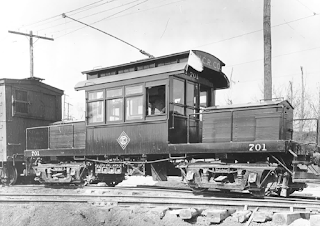 |
| Freight motors like Cincinnati & Lake Erie 640 were a common sight switching freight in Dayton. The clerestory roof is a nice touch, as this used to be a passenger coach. (Hicks Car Works) |
The final line to be absorbed, though not the last one chronologically, was the Dayton & Western Interurban (D&W). This was not so much an interurban passenger line, but instead an interurban freight interchange road. (Think the Illinois Terminal but just for electric railways.) This line enabled the Indiana Railroad (and before that, the THI&E) to connect to the Ohio-based Cincinnati and Lake Erie (C&LE) in one big, 108-mile single-service interchange. If not for this bridge traffic, the D&W would have been abandoned long ago, considering it was incredibly financially weak. Part of this was due to the new Route 40 being built Richmond, IN, and Dayton, OH, that made all the track crews pause in apprehension. The C&LE eventually leased the D&W to prop it up financially and ran it to keep up the interchange service from 1931 to 1933. The IR took over the D&W in 1936, but precarious financial positions meant that by 1937, the IR was forced to drop the lease and abandon the D&W. This loss of interchange freight put a severe dent in the IR's coffers, but by that point it was like a pinprick adding to an already gaping wound.
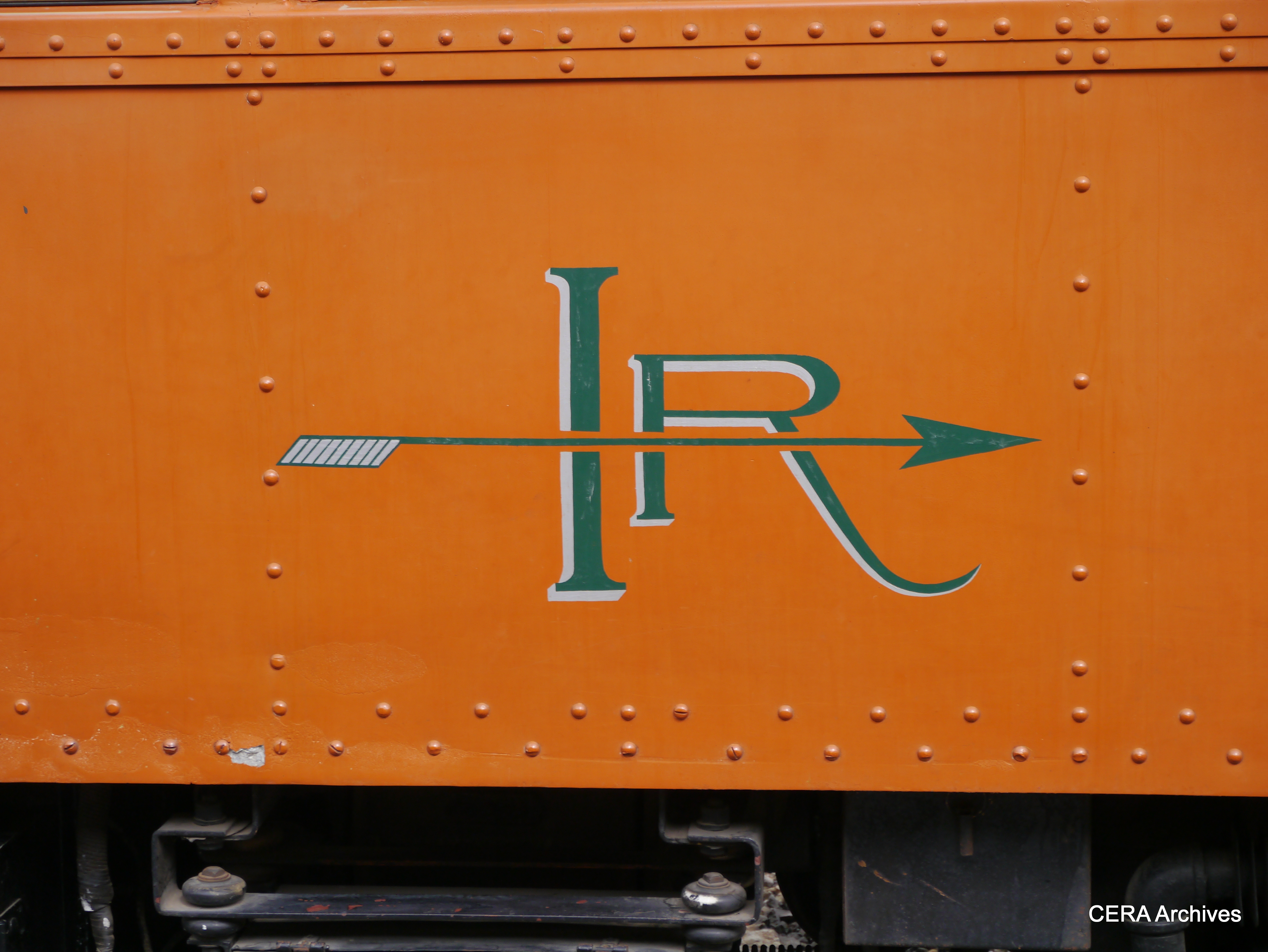 |
| The Indiana Railroad logo, as preserved on High Speed Car No. 65. (David Sadowski) |
 |
| Samuel Insull, in complete shock that he doesn't have the best interurban executive facial hair on this blog. (Getty Images) |
So how did all six of these companies actually come together? It could be supposed that due to all of them sharing a massive terminal building in Indianapolis, all six were bound to be merged at some point. Well, yes, but actually not really. The real reason for the single-company merger was thanks to (again) Samuel Insull. While he is more well known for his control of the Chicago interurban, Insull saw a great deal of opportunity in the public works sector in Indiana (which is how he first got involved with the South Shore Line). His company, Midland Utilities, originally owned the ISC, the Fort Wayne-Lima Railroad, and the Gary Railways directly by 1930. In 1932, Midland Utilities then purchased the THI&E, which brought the whole system to a decent 600 miles across the state. This also meant that Insull inherited a gaggle of out-of-date wood interurbans and city cars across six companies.
As with his operation of the Chicago Interurbans, Insull stressed the importance of state-of-the-art rolling stock. Gone were the 1910-era arch-windowed wooden coaches, replaced by smaller, lightweight interurban cars inspired by the C&LE and built by the American Car & Foundry (AC&F). Their small size, heavy Commonwealth Steel trucks, and light aluminum frame meant the "Indiana Railroad High Speeds" could make 400 horsepower and travel at a top speed of 83 miles per hour, even on some of the system's worst track. Their intense acceleration (should a motorman dare) also enabled the "High Speeds" to maintain an average service speed of 40 miles per hour. Inside, the cars were nothing to scoff at, as Insull also provided sumptuous comfort by having AC&F install thick patterned carpets, electric heating and fans, and modernist interior paint. 35 cars were built between 1931 and 1935, with the second group seized from the unrelated Northern Indiana Railway by their builder, Cummings, after Northern Indiana was deemed insolvent on their order payment.
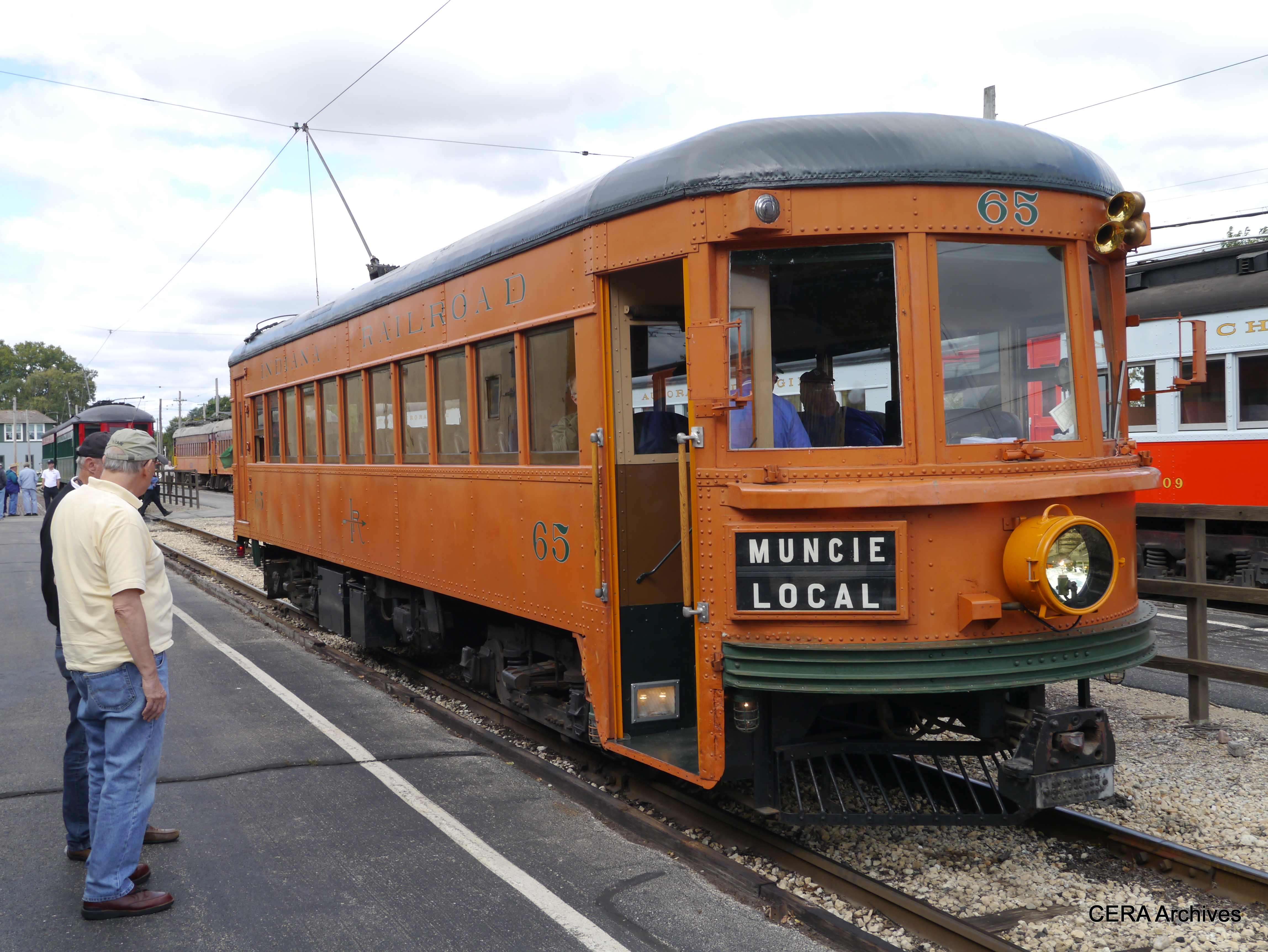 |
| Indiana Railroad No. 65, one of the "High Speed" interurban cars, works the Loop Service at the Illinois Railroad Museum's CERA 75 fantrip in 2013. (David Sadowski) |
| The Indiana Railroad at its peak, with all but the D&W listed. (No Attribution) |
However, the company could not have been formed at a worse time. The Great Depression killed off plenty of interurban growth and, even with the IR's strong freight and Less-than-Carload (LCL) box motor service, the magic of Samuel Insull wore off. One of the customers hit hardest by the eventual lack of freight service was the popular customer, Auburn Motorcars, whose parts were delivered from Terre Haute to Fort Wayne by the IR. Samuel Insull's Midland Utilities, worth a total of $500 million and a leveraged equity of $27 million, collapsed harshly and wiped out the savings of some 600,000 shareholders. This included the IR, which went into bankruptcy in 1933 and eventually found receivership under Bowman Elder. Elder, who found his hands full trying to control a statewide interurban, managed to accomplish the impossible from a public transit utility and made a profit by 1936 thanks to freight service on the Dayton & Western. Of course, the next year, IR slid into bankruptcy again as the Securities and Exchange Commission dissolved Midland Utilities, cutting IR off from their parent company's subsidized power generation. Between March of 1937 and January 1941, all lines were systematically closed.
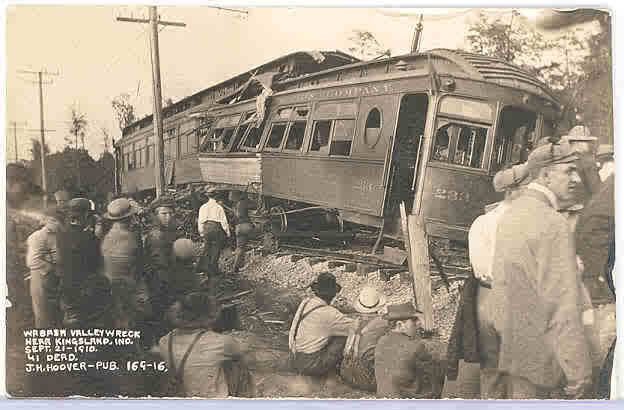 |
| The aftermath of the Kingsland interurban wreck. (IndyStar) |
What accelerated the rate of closure came from a violent wreck in 1941 that all but closed the book on the IR. Prior to this, the worst wreck in perhaps all of interurban history occurred on the old FW&WVT as mentioned earlier, on September 22, 1910. Two cars on the Bluffton branch collided after one train disregarded another's orders on what was allegedly a block signal system. Both trains collided at speed, leading to one telescoping into another on a sharp curve and leading to the deaths of 40 people. As both motormen died, it is unknown who was negligent.
This same incident occurred again, this time on the only remaining branch of the IR (now the Public Service Company of Indiana) between Indianapolis and Seymour, on September 8, 1941. One of the high speed cars had stalled on a service inbound to Indianapolis from Seymour, and a work train was sent down from Indianapolis to investigate. The problem was, the high speed car had started up again and was now barreling its way to Indianapolis. The car hit the freight motor at track speed, leading to the death of the motorman and one passenger. After all injured passengers and wrecked equipment was collected and cleaned, the Indianapolis-Seymour service was immediately halted and all track was torn up.
 |
| The modern Indiana Rail Road's logo. (Mark Vogel) |
The Indiana Railroad formed the last of Samuel Insull's interurban and railway holdings, but it was also one of the more unstable ones. Unlike the dependable and varied services of the North Shore, South Shore, or Roarin' Elgin, the Indiana Railroad's constituents were unstable from the start and the impact of the Great Depression just helped to make matters worse. In fact, by the time of the big wreck in 1941, the entity known as the "Indiana Railroad" had almost ceased to exist and only applied to one single-track operation. Today, a new "Indiana Rail Road" (space intentional) operates as a diesel-powered Class II railroad over some old Illinois Central tracks to Indianapolis. Almost all the old alignment is abandoned, with only a section between Speed and Watson Junction operated by the Southern Indiana Railroad. The Indiana Railroad was supposed to be the grandest and most developed of the Midwestern interurbans, but it ended up being one of the last to be created and the shortest lived.
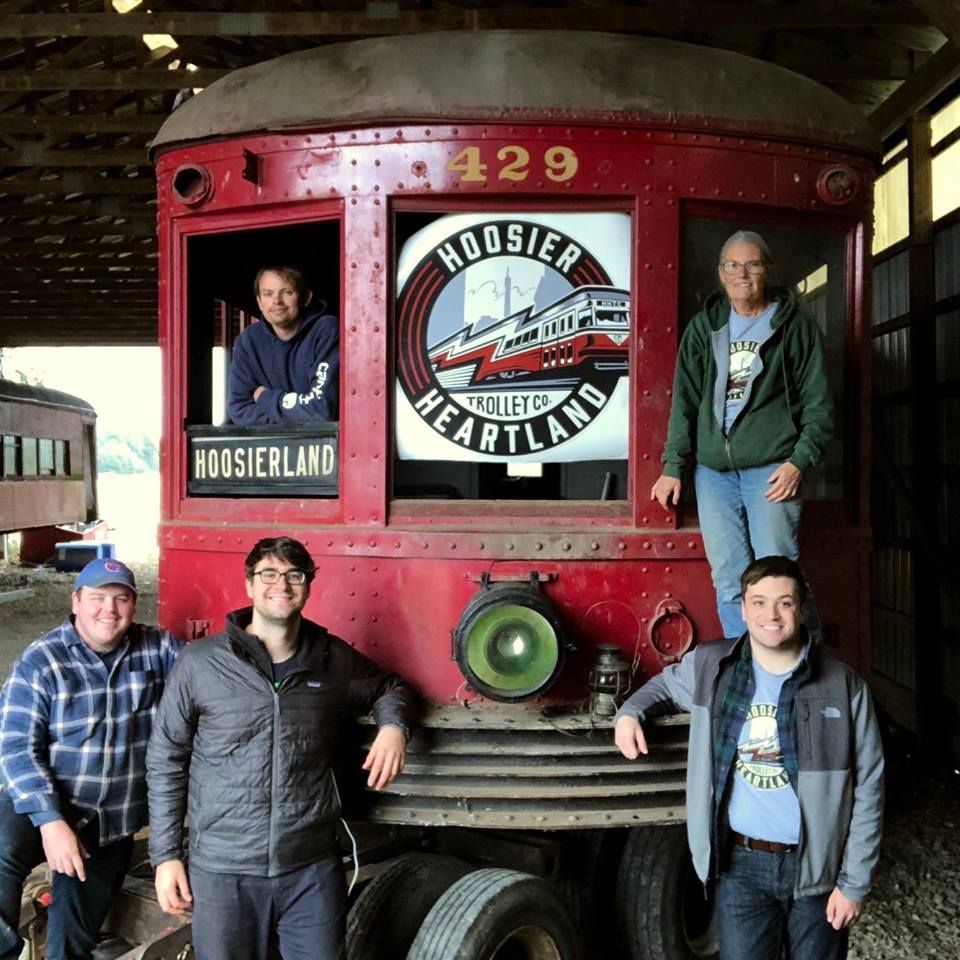 |
| The Hoosier Heartland Trolley Company with original car No. 429. No. 437 is on the left. (Hoosier Heartland Trolley Company) |
Thankfully, several cars have found a new lease on life in preservation. Some of the old steel combines from the ISC were sold to the South Shore and now two of them are preserved at the Illinois Railroad Museum, along with High Speed Car No. 65, which was the first to arrive on the museum property. Due to its single-end nature, however, Car 65 does not see much operation (due to the IRM only having one loop on the property). A second high speed car, No. 55, survives at the Seashore Trolley Museum in operation, having been sold to Lehigh Valley Transit after the IR went bust. Other trolleys went elsewhere, like the rare 1927 GC Kuhlman streetcar which was sold to the Portland Traction Company. The Hoosier Heartland Trolley Company, one of the few traction preservationists in Indiana, also kept two 400-series interurban cars from the ISC, Nos. 429 and 437. In all, over 13 cars from the IR survive in varying states, all continuing the legacy of what could have been another "First and Fastest" road.
-----

Thank you for such a well written article. It’s full of insightful information and entertaining descriptions. Your point of view is the best among many.
ReplyDeleteheathrow taxi transfer
I have been checking out a few of your stories and i can state pretty good stuff. I will definitely bookmark your blog
ReplyDeletegatwick airport transfer